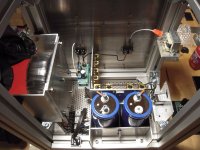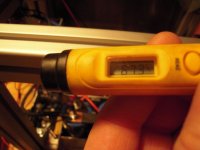If you want to build a 50W-SE-Schade-Monoblock and you want to bias it up to 3.1 A, then you are asking for heat
and a lot of aluminum to transfer that heat away.
My ones are working now for the last two years without any problems. Heatsink is made of a 8mm thick aluminum plate as heatspreader,
Modushop 5U - 300mm deep and 3U - 300mm deep heatsinks. And still around 67° C outside the heatsinks where the MosFet is mounted
inside. I can't go over 3.2 A bias - then the bias runs away...
Test it - and enjoy a 'warm' sound
Cheers
Dirk


and a lot of aluminum to transfer that heat away.
My ones are working now for the last two years without any problems. Heatsink is made of a 8mm thick aluminum plate as heatspreader,
Modushop 5U - 300mm deep and 3U - 300mm deep heatsinks. And still around 67° C outside the heatsinks where the MosFet is mounted
inside. I can't go over 3.2 A bias - then the bias runs away...
Test it - and enjoy a 'warm' sound
Cheers
Dirk


Attachments
That's a lot of Watts for one channel! What power supply voltage and what current? I would expect 385 Watts to cover two channels.If it is 385 watts per side I’m happy that I almost made it! 🤣
Heat is an understatement. My heatsinks are about 20 inches long (front to back), about 12 inches high, and the fins are about 2.25" tall. These heatsinks that were sitting on my shelf are huge compared to anything else I've built so I took a chance. I may have gotten away with it but after my heatsinks hit 60C I chickened out and put in a couple of small fans. I put a ton of work into this including making my own PCBs so I didn't want to see it go up in smoke.If you want to build a 50W-SE-Schade-Monoblock and you want to bias it up to 3.1 A, then you are asking for heat
and a lot of aluminum to transfer that heat away.
My ones are working now for the last two years without any problems. Heatsink is made of a 8mm thick aluminum plate as heatspreader,
Modushop 5U - 300mm deep and 3U - 300mm deep heatsinks. And still around 67° C outside the heatsinks where the MosFet is mounted
inside. I can't go over 3.2 A bias - then the bias runs away...
Test it - and enjoy a 'warm' sound
Cheers
Dirk

I'm easily misled so after I build Randy's Aleph 30 I might repurpose this chassis and turn it into an Aleph 2.
After all, we're amp builders?
Regards,
Dan
My calculator is rusty so I'm assuming the CCS portion of the circuit alone produces 192 watts of heat?That's a lot of Watts for one channel! What power supply voltage and what current? I would expect 385 Watts to cover two channels.
It depends on what voltage and current you are running. If your power supply is 60V and your current is 3.2A, the power dissipated is 60V x 3.2A = 192W, which is dissipated mostly by the two Mosfets and a tiny bit by the resistors. So the 192W is the total dissipation for the channel, not for the current source portion.
Thanks for the education. I'm smart, I'm just not as smart as ZM. 😉It depends on what voltage and current you are running. If your power supply is 60V and your current is 3.2A, the power dissipated is 60V x 3.2A = 192W, which is dissipated mostly by the two Mosfets and a tiny bit by the resistors. So the 192W is the total dissipation for the channel, not for the current source portion.
My next project (Randy's Aleph 30) will be another good real life lesson. The Aleph threads claims the 30 produces 100 watts of heat per channel.
Pa's DIY Chassis notes claims the 5U/400 I'm using is good for 158W. Should be a breeze?
Regards,
Dan 🙂
Pa's DIY Chassis notes claims the 5U/400 I'm using is good for 158W. Should be a breeze?
Regards,
Dan 🙂
no way, Jose, even if Pa said that
5U/400 ......... 100 to 110W per side, and changing caps every 3 years
5U/400 ......... 100 to 110W per side, and changing caps every 3 years
meaning - there is significant difference if you choose +25C, comparing to +30C figures
FAB is free to take +30C figure, while we are destined for less
are destined for less
FAB is free to take +30C figure, while we
 are destined for less
are destined for lessAnother interesting article to add to the great heatsink debate.
Design Considerations for a Class A Amplifier Enclosure
Regards,
Dan
Design Considerations for a Class A Amplifier Enclosure
Regards,
Dan
Last edited:
frankly, I don't need debate ........ besides not being smart enough to draw conclusions from any paper 
if I'm in doubt - I ask someone who's having experience with hsinks of interest
if there is no experience, time for proper in vivo test - fire up variac, big Donut, some hefty power resistors on hsink .......
yes, I believe in Pa's cunning, but he's too much cunning for me, mere Chicken

if I'm in doubt - I ask someone who's having experience with hsinks of interest
if there is no experience, time for proper in vivo test - fire up variac, big Donut, some hefty power resistors on hsink .......
yes, I believe in Pa's cunning, but he's too much cunning for me, mere Chicken
Does anybody know how this amp behaves with 4 and 16 ohm loads? If forced to choose between the two is one preferable to the other?
Edit: For context I'm wondering about driving a pair of dual-4ohm VC drivers that look like they hit about 30ohm in the box (winIsd). Hence being stuck with those to possibilities.
Edit: For context I'm wondering about driving a pair of dual-4ohm VC drivers that look like they hit about 30ohm in the box (winIsd). Hence being stuck with those to possibilities.
Last edited:
Hello Haze Head,
I can't really answer your question. But I have a 50W-SE-Schade-amp, that drives my 4 Ohm or 8 Ohm speakers with such an ease.
I have used this amp in an active speaker setup with the 6-24 AXO (active crossover) from Mr. Pass as well with some of my
passive speakers. But most of my speakers are pretty easy to drive. This amp has a lot of control.
I can't (and I think nobody can?) predict, how this amp will behave with your speaker setup.
If you have a strange impedance curve in your speaker behavior - normally with passive crossovers- but close to all speaker-
chassis have an impedance dip anywhere in the frequency range, than you could think about an impedance-correction - network
in your passive crossover (often done with speakers driven by tube-amps). Nothing new.
Cheers
Dirk
I can't really answer your question. But I have a 50W-SE-Schade-amp, that drives my 4 Ohm or 8 Ohm speakers with such an ease.
I have used this amp in an active speaker setup with the 6-24 AXO (active crossover) from Mr. Pass as well with some of my
passive speakers. But most of my speakers are pretty easy to drive. This amp has a lot of control.
I can't (and I think nobody can?) predict, how this amp will behave with your speaker setup.
If you have a strange impedance curve in your speaker behavior - normally with passive crossovers- but close to all speaker-
chassis have an impedance dip anywhere in the frequency range, than you could think about an impedance-correction - network
in your passive crossover (often done with speakers driven by tube-amps). Nothing new.
Cheers
Dirk
Thanks Dirk, I'm probably overthinking it. If you're driving whatever load with ease then I have my answer 👍
- Home
- Amplifiers
- Pass Labs
- 50w Single-Ended BAF2015 Schade Enabled

